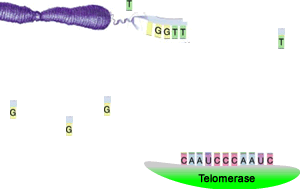Exercise ageing and telomeres
|
||
Chromosomes are units of tightly coiled DNA. A telomere is a repeating sequence of double-stranded DNA located at each end of a chromosome. Each time a cell divides, whether its for proliferation of immune cells, repair or differentiation through out the life of an organism, the telomere is shortened. When the telomeres of a particular cells become too small division is impossible. Undifferentiated cells such as stem cells and cancer cells have exceptionally long telomeres.
|
||
| An enzyme called telomerase lengthens telomeres by adding on repeating sequences of DNA, as shown on the right. Exactly how the enzyme does this is not important in this unit of work. It is sufficient to note that telomerase binds to the end of the telomere and adds repeating units to it. A second enzyme, DNA polymerase then comes along and completes the double stranded structure of the telomere. |  |
|
It has been observed that telomerase activity is very high in embryonic stem cells and cancer cells. Little telomerase activity is noticed in most mature, differentiated cell types.
The functions of telomeres and telomerase appear to be important in cell division and therefore cancer research, as well as the ageing process.